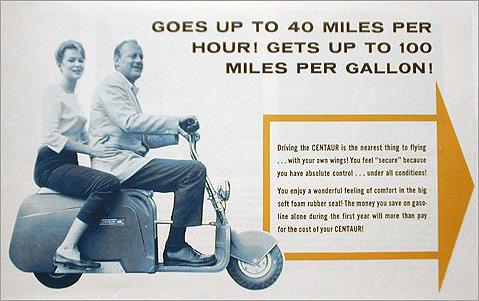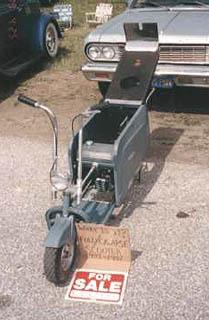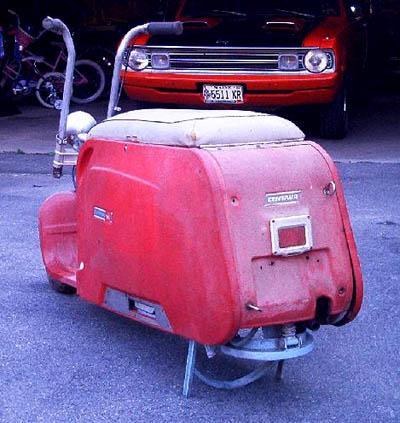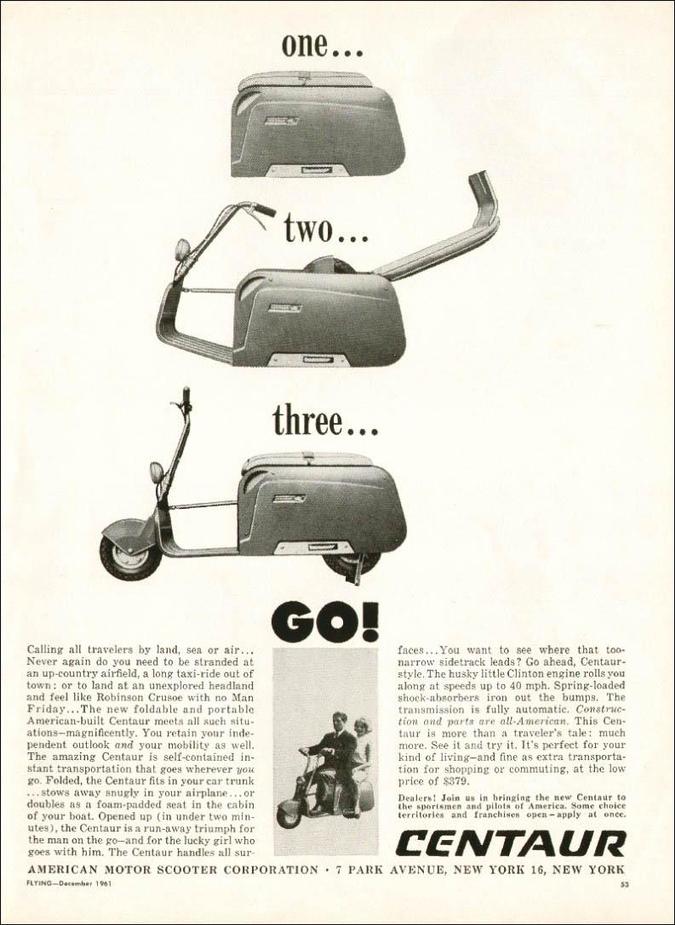 |
The |
|
LOOKING FOR CENTAUR INFORMATION AND
OTHER OWNERS? |
|
Centaur Motor Scooters – The Suitcase that Carried You Think suitcases with wheels are handy? How about a suitcase that provided travelers with wheels when they reached their destination? The Centaur motor scooter, built from 1960 until 1965, did just that. Designed as portable transportation for boat and small aircraft owners, hunters, and vacationers, the Centaur was a full-sized scooter that folded up to look like a large suitcase with a padded top. Of course, ‘portable’ is a relative term here. At 20” by 32” by 16”, a folded Centaur was not overly large, but it weighed 90 pounds dry. Not something you would want to lug long distances, but still not bad for transportation that was on par with many standard scooters of the era. Given the technology and materials of the day, the Centaur was a marvel of engineering and ingenuity. Every aspect of the scooter’s design was approached with an eye for transportability and function. Power was provided by a two-cycle motor with a sealed crankshaft bearing – no crankcase oil to leak. A unique, belt-driven variable-speed torque converter functioned as a fully automatic transmission. The gas tank had both a shutoff valve and a sealable vent that allowed the scooter to be stored in any position. Spring-loaded handlebars locked into position, providing standard hand controls. Even the seat retaining strap doubled as a carrying handle. The most fascinating element of scooter was how it all folded up into one neat package. Both the main support rod and the front wheel and fender assembly were held in place by hand-operated knurled nuts. You loosened the support rod, then removed the front wheel. The rear suspension lifted up to lock the whole chassis and rear tire inside the case. Then the front wheel assembly slipped into the right front next to the engine. Twisting the handlebars allowed the whole front half to slip inside the frame under the seat, which close so tightly that a recess had to be provided for the headlight. With practice, the scooter could be set up or put away in under one minute. The man behind the development of the Centaur was James Wilford Foster. A long-time scooter enthusiast, Foster and his wife Constance traveled all over Europe and Puerto Rico on scooters in the 1950s. He was in charge of establishing parts distribution for the Italian Lambretta scooter company in the United States and had a showroom in New York. However, Lambretta went through a major upheaval in 1959, and was forced to restrict export to the United States. About the same time, an acquaintance came up with the rough design for a portable scooter. The concept intrigued Foster, and he began working to turn the concept into a reality. Financial backing was obtained, and the American Motor Scooter Company was formed in 1960 with offices on Park Avenue in New York City, and initial manufacturing facilities in Youngstown, Ohio. Billed as the ‘All-American’ scooter, parts for the Centaur came from major manufacturers all over the country, including General Tire and Rubber, Alcoa Aluminum, and Raybestos. A key element was the ‘Dri-Draulic’ torque converter transmission developed by Walter Hoover, who was instrumental in the invention of the variable pitch propeller. Power was provided by a Clinton 5.2 horsepower go-cart engine hopped up with performance accessories from Go-Power Company. Period reviews credit the Centaur with a top speed of over 40 mph and better than 100 mpg. The novelty of the Centaur helped with publicity, earning coverage in Look Magazine, various travel publications, and assorted motorcycle and scooter publications. Ads promoted the portability of the scooter, and featured photos of Foster himself riding his product. Sales were good, and a strong distributorship began to appear across the country. However, the primary financial backer sold out to Lombard Industries Incorporated in 1962. Production of the Centaur was moved to Lombard’s facilities in Ashland, Massachusetts, and continued there for the next three years. In the spring of 1964, Lombard was acquired by American Lincoln Corporation. Although scooter sales continued to increase, the new owners decided to focus on chain saw operations. When manufacturing operations moved from Massachusetts to Toledo, Ohio in 1965, American Lincoln ended Centaur production. |
| November 19, 2006 - I received an email recently from Constance Foster, the widow of James Foster who designed and produced the Centaur. She had found the web site by accident and liked seeing information about her husband's creation. She was gracious enough to provide her phone number, and we had a really nice conversation about the Centaur today. Much of the history above came from that discussion. |
| October 23, 2004 - Got a
nice note from a Centaur scooter owner I was able to track down - he has set
up a great page of photos at:
http://www.geocities.com/quantexpeter/. Click on 'centaur scooter'
in the upper right corner to get to the pictures. I have set this page up in hopes of finding other Centaur scooter owners. If you have information to share on the Scooter's history, maintenance, or parts availability, let me know and I will post it here. I will also be glad to create a classified for free listing of Centaur items (assuming I don't buy them). For now, this page is a collection of images I have been able to gather from the Internet. As i get original material, I will scan it and add it to the collection. If you have any information on the history of the Centaur Folding Scooter, Lombard Industries, or the American Motor Scooter Corporation, or have parts and/or literature for the scooter, please contact me at posti@aol.com.
|
 |
 |
 |
